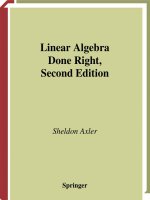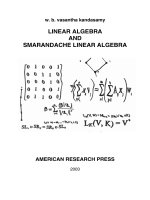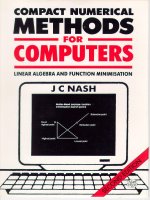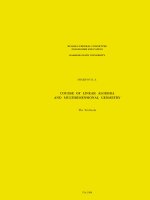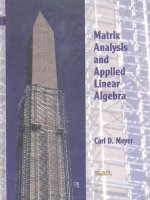Linear algebra: step by step
Bạn đang xem bản rút gọn của tài liệu. Xem và tải ngay bản đầy đủ của tài liệu tại đây (8.43 MB, 617 trang )
Linear Algebra
Linear Algebra
Step by Step
Kuldeep Singh
Senior Lecturer in Mathematics
University of Hertfordshire
3
3
Great Clarendon Street, Oxford, OX2 6DP,
United Kingdom
Oxford University Press is a department of the University of Oxford.
It furthers the University’s objective of excellence in research, scholarship,
and education by publishing worldwide. Oxford is a registered trade mark of
Oxford University Press in the UK and in certain other countries
c Kuldeep Singh 2014
The moral rights of the author have been asserted
First Edition published in 2014
Impression: 1
All rights reserved. No part of this publication may be reproduced, stored in
a retrieval system, or transmitted, in any form or by any means, without the
prior permission in writing of Oxford University Press, or as expressly permitted
by law, by licence or under terms agreed with the appropriate reprographics
rights organization. Enquiries concerning reproduction outside the scope of the
above should be sent to the Rights Department, Oxford University Press, at the
address above
You must not circulate this work in any other form
and you must impose this same condition on any acquirer
Published in the United States of America by Oxford University Press
198 Madison Avenue, New York, NY 10016, United States of America
British Library Cataloguing in Publication Data
Data available
Library of Congress Control Number: 2013947001
ISBN 978–0–19–965444–4
Printed in the UK by
Bell & Bain Ltd, Glasgow
Links to third party websites are provided by Oxford in good faith and
for information only. Oxford disclaims any responsibility for the materials
contained in any third party website referenced in this work.
Preface
My interest in mathematics began at school. I am originally of Sikh descent, and as a young child
often found English difficult to comprehend, but I discovered an affinity with mathematics, a universal
language that I could begin to learn from the same start point as my peers.
Linear algebra is a fundamental area of mathematics, and is arguably the most powerful mathematical
tool ever developed. It is a core topic of study within fields as diverse as business, economics, engineering, physics, computer science, ecology, sociology, demography and genetics. For an example of linear
algebra at work, one need look no further than the Google search engine, which relies on linear algebra
to rank the results of a search with respect to relevance.
My passion has always been to teach, and I have held the position of Senior Lecturer in Mathematics
at the University of Hertfordshire for over twenty years, where I teach linear algebra to entry level
undergraduates. I am also the author of Engineering Mathematics Through Applications, a book that I
am proud to say is used widely as the basis for undergraduate studies in many different countries. I also
host and regularly update a website dedicated to mathematics.
At the University of Hertfordshire we have over one hundred mathematics undergraduates. In the
past we have based our linear algebra courses on various existing textbooks, but in general students
have found them hard to digest; one of my primary concerns has been in finding rigorous, yet accessible
textbooks to recommend to my students. Because of the popularity of my previously published book, I
have felt compelled to construct a book on linear algebra that bridges the considerable divide between
school and undergraduate mathematics.
I am somewhat fortunate in that I have had so many students to assist me in evaluating each chapter.
In response to their reactions, I have modified, expanded and added sections to ensure that its content
entirely encompasses the ability of students with a limited mathematical background, as well as the
more advanced scholars under my tutelage. I believe that this has allowed me to create a book that is
unparalleled in the simplicity of its explanation, yet comprehensive in its approach to even the most
challenging aspects of this topic.
Level
This book is intended for first- and second-year undergraduates arriving with average mathematics
grades. Many students find the transition between school and undergraduate mathematics difficult,
and this book specifically addresses that gap and allows seamless progression. It assumes limited prior
mathematical knowledge, yet also covers difficult material and answers tough questions through the use
of clear explanation and a wealth of illustrations. The emphasis of the book is on students learning for
themselves by gradually absorbing clearly presented text, supported by patterns, graphs and associated
questions. The text allows the student to gradually develop an understanding of a topic, without the
need for constant additional support from a tutor.
Pedagogical Issues
The strength of the text is in the large number of examples and the step-by-step explanation of each topic
as it is introduced. It is compiled in a way that allows distance learning, with explicit solutions to all of
vi
PREFACE
the set problems freely available online < The miscellaneous
exercises at the end of each chapter comprise questions from past exam papers from various universities,
helping to reinforce the reader’s confidence. Also included are short historical biographies of the leading
players in the field of linear algebra. These are generally placed at the beginning of a section to engage
the interest of the student from the outset.
Published textbooks on this subject tend to be rather static in their presentation. By contrast, my book
strives to be significantly more dynamic, and encourages the engagement of the reader with frequent
question and answer sections. The question–answer element is sprinkled liberally throughout the text,
consistently testing the student’s understanding of the methods introduced, rather than requiring them
to remember by rote.
The simple yet concise nature of its content is specifically designed to aid the weaker student, but
its rigorous approach and comprehensive manner make it entirely appropriate reference material for
mathematicians at every level. Included in the online resource will be a selection of MATLAB scripts,
provided for those students who wish to process their work using a computer.
Finally, it must be acknowledged that linear algebra can appear abstract when first encountered by
a student. To show off some of its possibilities and potential, interviews with leading academics and
practitioners have been placed between chapters, giving readers a taste of what may be to come once
they have mastered this powerful mathematical tool.
Acknowledgements
I would particularly like to thank Timothy Peacock for his signficant help in improving this text. In
addition I want to thank Sandra Starke for her considerable contribution in making this text accessible.
Thanks too to the OUP team, in particular Keith Mansfield, Viki Mortimer, Smita Gupta and Clare
Charles.
Dedication
To Shaheed Bibi Paramjit Kaur
Contents
1
Linear Equations and Matrices
1.1
1.2
1.3
1.4
1.5
1.6
1.7
1.8
Systems of Linear Equations
Gaussian Elimination
Vector Arithmetic
Arithmetic of Matrices
Matrix Algebra
The Transpose and Inverse of a Matrix
Types of Solutions
The Inverse Matrix Method
1
1
12
27
41
57
75
91
105
Des Higham Interview
127
Euclidean Space
129
2.1
2.2
2.3
2.4
129
143
159
171
2
Properties of Vectors
Further Properties of Vectors
Linear Independence
Basis and Spanning Set
Chao Yang Interview
3
General Vector Spaces
191
3.1
3.2
3.3
3.4
3.5
3.6
191
202
216
229
239
254
Introduction to General Vector Spaces
Subspace of a Vector Space
Linear Independence and Basis
Dimension
Properties of a Matrix
Linear Systems Revisited
Janet Drew Interview
4
275
Inner Product Spaces
277
4.1
4.2
4.3
4.4
277
290
306
321
Introduction to Inner Product Spaces
Inequalities and Orthogonality
Orthonormal Bases
Orthogonal Matrices
Anshul Gupta Interview
5
190
338
Linear Transformations
339
5.1
5.2
5.3
5.4
5.5
5.6
339
352
364
372
389
407
Introduction to Linear Transformations
Kernel and Range of a Linear Transformation
Rank and Nullity
Inverse Linear Transformations
The Matrix of a Linear Transformation
Composition and Inverse Linear Transformations
Petros Drineas Interview
429
viii
CONTENTS
6
Determinants and the Inverse Matrix
431
6.1
6.2
6.3
6.4
431
439
455
472
Determinant of a Matrix
Determinant of Other Matrices
Properties of Determinants
LU Factorization
Franỗoise Tisseur Interview
7
490
Eigenvalues and Eigenvectors
491
7.1
7.2
7.3
7.4
7.5
491
503
518
533
547
Introduction to Eigenvalues and Eigenvectors
Properties of Eigenvalues and Eigenvectors
Diagonalization
Diagonalization of Symmetric Matrices
Singular Value Decomposition
Brief Solutions
567
Index
605
.............................................................................................
1
Linear Equations
and Matrices
.............................................................................................
SECTION 1.1
Systems of Linear Equations
By the end of this section you will be able to
1.1.1
●
solve a linear system of equations
●
plot linear graphs and determine the type of solutions
Introduction to linear algebra
We are all familiar with simple one-line equations. An equation is where two mathematical
expressions are defined as being equal. Given 3x = 6, we can almost intuitively see that x
must equal 2.
However, the solution isn’t always this easy to find, and the following example demonstrates how we can extract information embedded in more than one line of information.
Imagine for a moment that John has bought two ice creams and two drinks for £3.00.
How much did John pay for each item?
Let x = cost of ice cream and y = cost of drink, then the problem can be written as
2x + 2y = 3
At this point, it is impossible to find a unique value for the cost of each item. However, you are
then told that Jane bought two ice creams and one drink for £2.50. With this additional information, we can model the problem as a system of equations and look for unique values for the cost
of ice creams and drinks. The problem can now be written as
2x + 2y = 3
2x + y = 2.5
Using a bit of guesswork, we can see that the only sensible values for x and y that satisfy both
equations are x = 1 and y = 0.5. Therefore an ice cream must have cost £1.00 and a drink £0.50.
Of course, this is an extremely simple example, the solution to which can be found with
a minimum of calculation, but larger systems of equations occur in areas like engineering,
science and finance. In order to reliably extract information from multiple linear equations,
we need linear algebra. Generally, the complex scientific, or engineering problem can be
solved by using linear algebra on linear equations.
2
1 LINEAR EQUATIONS AND MATRICES
What does the term linear equation mean?
An equation is where two mathematical expressions are defined as being equal.
A linear equation is one where all the variables such as x, y, z have index (power) of 1 or
0 only, for example
x + 2y + z = 5
is a linear equation. The following are also linear equations:
x = 3; x + 2y = 5; 3x + y + z + w = −8
The following are not linear equations:
1. x2 − 1 = 0
2. x + y4 +
√
z=9
3. sin(x) − y + z = 3
Why not?
In equation (1) the index (power) of the variable x is 2, so this is actually a quadratic equation.
√
In equation (2) the index of y is 4 and z is 1/2. Remember, z = z1/2 .
In equation (3) the variable x is an argument of the trigonometric function sine.
Note that if an equation contains an argument of trigonometric, exponential, logarithmic
or hyperbolic functions then the equation is not linear.
A set of linear equations is called a linear system.
In this first course on linear algebra we examine the following questions regarding linear
systems:
●
Are there any solutions?
●
Does the system have no solution, a unique solution or an infinite number of
solutions?
●
How can we find all the solutions, if they exist?
●
Is there some sort of structure to the solutions?
Linear algebra is a systematic exploration of linear equations and is related to ‘a new kind
of arithmetic’ called the arithmetic of matrices which we will discuss later in the chapter.
However, linear algebra isn’t exclusively about solving linear systems. The tools of matrices and vectors have a whole wealth of applications in the fields of functional analysis and
quantum mechanics, where inner product spaces are important. Other applications include
optimization and approximation where the critical questions are:
1. Given a set of points, what’s the best linear model for them?
2. Given a function, what’s the best polynomial approximation to it?
To solve these problems we need to use the concepts of eigenvalues and eigenvectors and
orthonormal bases which are discussed in later chapters.
In all of mathematics, the concept of linearization is critical because linear problems are
very well understood and we can say a lot about them. For this reason we try to convert
many areas of mathematics to linear problems so that we can solve them.
SYSTEMS OF LINEAR EQUATIONS
1.1.2
System of linear equations
We can plot linear equations on a graph. Figure 1.1 shows the example of the two linear
equations we discussed earlier.
y
3
Point of intersection
2
2x + 2 y = 3
1
–1
1
2
3
x
–1
2x + y = 2.5
–2
Figure 1.1
Figure 1.2 is an example of the linear equation, x + y + 2z = 0, in a 3d coordinate
system.
4
3
2
1
z
0
-1
-2
x + y + 2z = 0
-3
-4
0 1 2
-4 -4 -3 -2 -1
-3
y
-2
-1
0
1
x
2
3
4
3 4
Figure 1.2
What do you notice about the graphs of linear equations?
They are straight lines in 2d and a plane in 3d. This is why they are called linear equations and the
study of such equations is called linear algebra.
What does the term system of linear equations mean?
Generally a finite number of linear equations with a finite number of unknowns x, y, z, w, . . . is
called a system of linear equations or just a linear system.
3
4
1 LINEAR EQUATIONS AND MATRICES
For example, the following is a linear system of three simultaneous equations with three
unknowns x, y and z:
x + 2y − 3z = 3
2x − y − z = 11
3x + 2y + z = −5
In general, a linear system of m equations in n unknowns x1 , x2 , x3 , . . . , xn is written
mathematically as
a11 x1 + a12 x2 + · · · + a1n xn = b1
a21 x1 + a22 x2 + · · · + a2n xn = b2
..
..
..
..
.
.
.
.
(∗ )
am1 x1 + am2 x2 + · · · + amn xn = bm
where the coefficients aij and bj represent real numbers. The unknowns x1 , x2 , . . . , xn are
placeholders for real numbers.
Linear algebra involves using a variety of methods for finding solutions to linear systems
such as (∗ ).
Example 1.1
Solve the equations about the cost of ice creams and drinks by algebraic means
2x + 2y = 3
2x + y = 2.5
(1)
(2)
Solution
How do we solve these linear simultaneous equations, (1) and (2)?
Let’s think about the information contained in these equations. The x in the first line represents the cost
of an ice cream, so must have the same value as the x in the second line. Similarly, the y in the first line
that represents the cost of a drink must have the same value as the y in the second line.
It follows that we can combine the two equations to see if together they offer any useful information.
How?
In this case, we subtract equation (2) from equation (1):
2x + 2y = 3
(1)
−(2x + y = 2.5)
(2)
0 + y = 0.5
Note that the unknown x is eliminated in the last line which leaves y = 0.5.
What else do we need to find?
The other unknown x.
SYSTEMS OF LINEAR EQUATIONS
How?
By substituting y = 0.5 into equation (1):
2x + 2 (0.5) = 3 implies that 2x + 1 = 3 gives x = 1
Hence the cost of an ice cream is £1 because x = 1 and the cost of a drink is £0.50 because y = 0.5;
this is the solution to the given simultaneous equations (1) and (2).
This is also the point of intersection, (1, 0.5), of the graphs in Fig. 1.1. The procedure outlined in
Example 1.1 is called the method of elimination. The values x = 1 and y = 0.5 is the solution of
equations (1) and (2). In general, values which satisfy the above linear system are called the solution or
the solution set of the linear system. Here is another example.
Example 1.2
Solve
9x + 3y = 6
(1)
2x − 7y = 9
(2)
Solution
We need to find the values of x and y which satisfy both equations.
How?
Taking one equation from the other doesn’t help us here, but we can multiply through either or both
equations by a non-zero constant.
If we multiply equation (1) by 2 and (2) by 9 then in both cases the x coefficient becomes 18. Carrying
out this operation we have
18x + 6y = 12
multiplying equation (1) by 2
18x − 63y = 81
multiplying equation (2) by 9
How do we eliminate x from these equations?
To eliminate the unknown x we subtract these equations:
18x + 6y = 12
−(18x − 63y = 81)
0 + [6 − (−63)] y = 12 − 81
subtracting
69y = −69
which gives y = −1
We have y = −1.
What else do we need to find?
The value of the placeholder x.
How?
By substituting y = −1 into the given equation 9x + 3y = 6:
9x + 3 (−1) = 6
9x − 3 = 6
9x = 9 which gives x = 1
(continued...)
5
6
1 LINEAR EQUATIONS AND MATRICES
Hence our solution to the linear system of (1) and (2) is
x = 1 and y = −1
We can check that this is the solution to the given system, (1) and (2), by substituting these values,
x = 1 and y = −1, into the equations (1) and (2).
Note that we can carry out the following operations on a linear system of equations:
1. Interchange any pair of equations.
2. Multiply an equation by a non-zero constant.
3. Add or subtract one equation from another.
By carrying out these steps 1, 2 and 3 we end up with a simpler linear system to solve,
but with the same solution set as the original linear system. In the above case we had
9x + 3y = 6
2x − 7y = 9
9x + 3y = 6
69y = −69
Of course, the system on the right hand side was much easier to solve. We can also
use this method of elimination to solve three simultaneous linear equations with three
unknowns, such as the one in the next example.
Example 1.3
Solve the linear system
x + 2y + 4z = 7
3x + 7y + 2z = −11
2x + 3y + 3z = 1
(1)
(2)
(3)
Solution
What are we trying to find?
The values of x, y and z that satisfy all three equations (1), (2) and (3).
How do we find the values of x, y and z?
By elimination. To eliminate one of these unknowns, we first need to make the coefficients of x (or y or z)
equal.
Which one?
There are three choices but we select so that the arithmetic is made easier, in this case it is x. Multiply
equation (1) by 2 and then subtract the bottom equation (3):
2x + 4y + 8z = 14
−(2x + 3y + 3z = 1)
0 + y + 5z = 13
multiplying (1) by 2
(3)
subtracting
SYSTEMS OF LINEAR EQUATIONS
Note that we have eliminated x and have the equation y + 5z = 13.
How can we determine the values of y and z from this equation?
We need another equation with only y and z.
How can we get this?
Multiply equation (1) by 3 and then subtract the second equation (2):
3x + 6y + 12z = 21
−(3x + 7y + 2z = −11)
multiplying (1) by 3
(2)
0 − y + 10z = 32
subtracting
Again there is no x and we have the equation −y + 10z = 32.
How can we find y and z?
We now solve the two simultaneous equations that we have obtained
y + 5z = 13
−y + 10z = 32
(4)
(5)
We add equations (4) and (5), because y + −y = 0, which eliminates y.
0 + 15z = 45 gives z =
45
=3
15
Hence z = 3, but how do we find the other two unknowns x and y?
We first determine y by substituting z = 3 into equation (4) y + 5z = 13:
y + (5 × 3) = 13
y + 15 = 13
which gives y = −2
We have y = −2 and z = 3. We still need to find the value of last unknown x.
How do we find the value of x?
By substituting the values we have already found, y = −2 and z = 3, into the given equation
x + 2y + 4z = 7 (1) :
x + (2 × −2) + (4 × 3) = 7 gives x = −1
Hence the solution of the given three linear equations is x = −1, y = −2 and z = 3.
We can illustrate the given equations in a three-dimensional coordinate system as shown in Fig. 1.3.
Solution
x = −1, y = −2, z = 3
3.5
3
x + 2y + 4z = 7
z 2.5
2
3x + 7y + 2z = –11
1.5
1
-1.5
2x + 3y + 3z = 1
-3 -2 y
-1
x
-0.5
Figure 1.3
7
8
1 LINEAR EQUATIONS AND MATRICES
Each of the equations (1), (2) and (3) are represented by a plane in a three-dimensional
system. The computer generated image above allows us to see where these planes lie with
respect to each other. The coordinates of these planes is the solution of the system.
The aim of the above problem was to convert the given system into something simpler
that could be solved. We had
x + 2y + 4z = 7
3x + 7y + 2z = −11
2x + 3y + 3z = 1
x + 2y + 4z = 7
−y + 2z = 32
15z = 45
We will examine in detail m equations with n unknowns and develop a more efficient
way of solving these later in this chapter.
1.1.3 Types of solutions
We now go back to evaluating a simple system of two linear simultaneous equations and
discuss the case where we have no, or an infinite number of solutions. As stated earlier, one
of the fundamental questions of linear algebra is how many solutions do we have of a given
linear system.
Example 1.4
Solve the linear system
2x + 3y = 6
4x + 6y = 9
(1)
(2)
Solution
How do we solve these equations?
Multiply (1) by 2 and then subtract equation (2):
4x + 6y = 12
−(4x + 6y = 9)
Multiplying (1) by 2
(2)
0+ 0 = 3
But how can we have 0 = 3?
A plot of the graphs of the given equations is shown in Fig. 1.4.
Y
These equations have no solutions.
3
2
2 x + 3y = 6
1
4x + 6y = 9
–1
1
2
–1
Figure 1.4
3
4
x
SYSTEMS OF LINEAR EQUATIONS
Can you see why there is no common solution to these equations?
The solution of the given equations would be the intersection of the lines shown in Fig. 1.4, but these
lines are parallel so there is no intersection, therefore no solution.
By examining the given equations,
2x + 3y = 6
4x + 6y = 9
(1)
(2)
can you see why there is no solution?
If you multiply the first equation (1) by 2 we have
4x + 6y = 12
This is a contradiction.
Why?
Because we have
4x + 6y = 12
4x + 6y = 9
(2)
that is, 4x + 6y equals both 9 and 12. This is clearly impossible. Hence the given linear system has no
solution.
A system that has no solution is called inconsistent. If the linear system has at least one
solution then we say the system is consistent.
Can we have more than one solution?
Consider the following example.
Example 1.5
Graph the equations and determine the solution of this system:
2x + 3y = 6
4x + 6y = 12
(1)
(2)
Solution
The graph of the given equations is shown in Fig. 1.5.
Y
3
2
4 x + 6y = 12
1
–1
2 x + 3y = 6
1
2
3
4
x
–1
Figure 1.5
(continued...)
9
10
1 LINEAR EQUATIONS AND MATRICES
What do you notice?
Both the given equations produce exactly the same line; that is they coincide.
How many solutions do these equations have?
An infinite number of solutions, as you can see on the graph of Fig. 1.5. Any point on the line is a solution,
and since there are an infinite number of points on the line we have an infinite number of solutions.
How can we write these solutions?
Let x = a – where a is any real number – be a solution.
What then is y equal to?
Substituting x = a into the given equation (1) yields
2a + 3y = 6
[2x + 3y = 6]
3y = 6 − 2a
6 − 2a
6
2
2
y=
= − a= 2− a
3
3
3
3
Hence if x = a then y = 2 − 23 a.
The solution of the given linear system, (1) and (2), is x = a and y = 2 − 2a/3 where a is any real
number. You can check this by substituting various values of a. For example, if a = 1 then
x = 1, y = 2 − 2(1)/3 = 4/3
We can check that this answer is correct by substituting these values, x = 1 and y = 4/3, into
equations (1) and (2):
⎡
2 (1) + 3 (4/3) = 2 + 4 = 6
4 (1) + 6 (4/3) = 4 + 8 = 12
⎣
2x + 3y = 6
(1)
4x + 6y = 12
(2)
⎤
⎦
Hence our solution works. This solution x = a and y = 2 − 2a/3 will satisfy the given equations for
any real value of a.
The graphs in Fig. 1.6 represent the three possible solutions to a linear system with two
unknowns.
y
—4
4
4
2
2
—2
y
y
2
4
x
—4
5
2
—2
—2
—2
—4
—4
(a) No solution
10
4
Solution
x
—10 —8 —6 —4 —2
2
4
x
—5
—10
(b) Unique solution
Figure 1.6
(c) Infinite number of solutions
SYSTEMS OF LINEAR EQUATIONS
The graphs in Fig. 1.7 illustrate solutions arising from three linear equations and three
unknowns.
(a) No solution
(b) Unique solution
Unique
solution
Every point on this
line is a solution
because all three
planes meet here.
(c) Infinite number of solutions
Figure 1.7
Fig. 1.7(a) shows three planes (equations) which have no point in common, hence no
solution.
Fig. 1.7(b) shows the three planes (equations) with a unique point in common.
Fig. 1.7(c) shows three planes (equations) with a line in common. Every point on this
line is a solution, which means we have an infinite number of solutions.
i
Summary
A linear equation is an equation in which the unknowns have an index of 1 or 0.
The procedure outlined in this section to solve such systems is the method of elimination.
EXERCISES 1.1
(Brief solutions at end of book. Full solutions available at < />companion/singh>.)
1. Which of the following equations are linear equations in x, y and z? If they are not linear
explain why not.
(a) x − y − z = 3
√
x+y+z =6
√
(e) x − 2y + 5z = 3
(b)
(c) cos (x) + sin y = 1
(d) ex+y+z = 1
(f) x = −3y
√
√
−b ± b2 − 4ac
1
(g) x =
(h) π x + y + ez = 5
(i) 2x + y + z = 0
2a
2
√
√
π
(j) sinh−1 (x) = ln x + x2 + 1 (k) x − 2y + z sin (π ) = 0
2
0
0
0
2
2
(l) x2 + y3 + z3 = 0
(m) ycos (x)+sin (x) + x − z = 9
11
12
1 LINEAR EQUATIONS AND MATRICES
2. Solve the following linear system by the elimination process discussed in this section.
(a)
x+y=2
x−y=0
(b)
2x − 3y = 5
x−y = 2
(c)
2x − 3y = 35
x−y = 2
5x − 7y = 2
π x − 5y = 2
ex − ey = 2
(e)
(f)
9x − 3y = 6
πx − y = 1
ex + ey = 0
(In part (f), e is the irrational number e = 2.71828182846 · · · )
(d)
3. Solve the following linear systems by the elimination process discussed in this section.
x+y+z = 3
(a) x − y − z = −1
2x + y + 5z = 8
x + 2y − 2z = 6
(b) 2x − 3y + z = −10
3x − y + 3z = −16
3x + y − 2z = 4
(c) 5x − 3y + 10z = 32
7x + 4y + 16z = 13
6x − 3y + 2z = 31
(d) 5x + y + 12z = 36
8x + 5y + z = 11
4. Plot the graphs of these linear equations and decide on the number of solutions of each
linear system. If there are any solutions, find them.
2x + y = 3
2x + y = 3
(a)
(b)
x−y=7
8x + 4y = 12
(d)
3x − 2y = 3
3x − 2y = 6
(f)
5x − 2y − 5 = 0
3x − 2y − 3 = 0
(e)
(c)
2x + y = 3
2x + y = 5
3x − 2y − 3 = 0
3x − 2y − 5 = 0
5. Without evaluating, decide on the number of solutions of each of these linear systems.
(a)
7x + y = 10
x−y = 7
(c)
2x − y − z = 3
4x − 2y − 2z = 3
(b)
12x + 4y = 16
8x + 4y = 16
........................................................................................................................
SECTION 1.2
Gaussian Elimination
By the end of this section you will be able to
●
understand what is meant by a matrix and an augmented matrix
●
solve a linear system using Gaussian elimination
●
extend row operations so that the solution can be found by inspection
GAUSSIAN ELIMINATION
In the previous section we solved a linear system by a process of elimination and substitution. In this section we define this process in a systematic way. In order to do this we need
to describe what is meant by a matrix and reduced row echelon form. Just by examining
the matrix of a given linear system in reduced row echelon form we can say a lot of things
about the solutions:
1. Are there any solutions?
2. Is the solution unique?
3. Are there an infinite number of solutions?
1.2.1
Introduction to matrices
In our introductory example from the previous section, we formed two equations that
described the cost of ice creams x and drinks y:
2x + 2y = 3
2x + y = 2.5
Note that the first column of values only contains coefficients of x, and the second
column only contains coefficients of y. So we can write
x y
2 2
,
2 1
3
2.5
The brackets on the left contain the coefficients from the problem, and is referred to as
the matrix of coefficients. The brackets on the right hand side contain the total cost in a
single column, and is referred to as a vector.
Matrices are used in various fields of engineering, science and economics to solve reallife problems such as those in control theory, electrical principles, structural analysis, string
theory, quantitative finance and many others. Problems in these areas can often be written as a set of linear simultaneous equations. It is easier to solve these equations by using
matrices.
Table 1.1 shows the sales of three different ice cream flavours during the week.
Table 1.1 Ice cream sales
Strawberry
Vanilla
Chocolate
Monday
Tuesday
Wednesday
Thursday
Friday
12
5
8
15
9
12
10
14
10
16
7
9
12
10
15
We can represent the information in the table in matrix form as
⎛
⎞
12 15 10 16 12
⎝ 5 9 14 7 10 ⎠
8 12 10 9 15
13
14
1 LINEAR EQUATIONS AND MATRICES
The first column represents the ice cream sales for Monday, second column for Tuesday,
. . . and the last column for Friday.
Matrices are an efficient way of storing data. In the next section we look formally at the
methods used to extract information from the data.
1.2.2
Elementary row operations
Suppose we have a general linear system of m equations with n unknowns labelled
x1 , x2 , x3 , . . . and xn given by:
a11 x1 + a12 x2 + · · · + a1n xn = b1
a21 x1 + a22 x2 + · · · + a2n xn = b2
..
.
..
.
..
.
..
.
am1 x1 + am2 x2 + · · · + amn xn = bm
where the coefficients aij , bi are real numbers and x1 , x2 , x3 , . . . and xn are placeholders for
real numbers that satisfy the equations. This general system can be stored in matrix form as
⎛
a11 . . . a1n
⎜ . .
⎜ ..
. . ...
⎝
am1 · · · amn
b1
⎞
⎟
⎟
⎠
bm
This is an augmented matrix, which is a matrix containing the coefficients of the
unknowns x1 , x2 , x3 , . . . , xn and the constant values on the right hand side of the
equations. In everyday English language, augmented means ‘to increase’. Augmenting
a matrix means adding one or more columns to the original matrix. In this case, we
have added the b’s column to the matrix. These are divided by a vertical line as shown
above.
Example 1.6
Consider Example 1.3 section 1.1, where we had to solve the following linear system:
x + 2y + 4z = 7
3x + 7y + 2z = −11
2x + 3y + 3z = 1
Write the augmented matrix of this linear system.
GAUSSIAN ELIMINATION
Solution
An augmented matrix is simply a shorthand way of representing a linear system of equations. Rather than
write x, y and z after each coefficient, recognize that the first column contains the coefficients of x, the
second column the coefficients of y and so on. Placing the coefficients of x, y and z on the left hand side
of the vertical line in the augmented matrix and the constant values 7, −11 and 1 on the right hand side
we have
⎛
1 2 4
⎝3 7 2
2 3 3
⎞
7
−11 ⎠
1
In the previous section 1.1 we solved these equations by an elimination process which
involved carrying out the following operations:
1. Multiply an equation by a non-zero constant.
2. Add or subtract a multiple of one equation to another.
3. Interchange equations.
Because each row of the augmented matrix corresponds to one equation of the linear
system, we can carry out analogous operations such as:
1. Multiply a row by a non-zero constant.
2. Add or subtract a multiple of one row to another.
3. Interchange rows.
We refer to these operations as elementary row operations.
1.2.3
Gaussian elimination
Gauss (1777–1855) (Fig. 1.8) is widely regarded as one
of the three greatest mathematicians of all time, the
others being Archimedes and
√ Newton. By the age of
11, Gauss could prove that 2 is irrational. At the age
of 18, he constructed a regular 17-sided polygon with
a compass and unmarked straight edge only. Gauss
went as a student to the world-renowned centre for
mathematics – Göttingen. Later in life, Gauss took up a
post at Göttingen and published papers in number
theory, infinite series, algebra, astronomy and optics.
The unit of magnetic induction is named after Gauss.
Figure 1.8
15
16
1 LINEAR EQUATIONS AND MATRICES
A linear system of equations is solved by carrying out the above elementary row operations 1, 2 and 3 to find the values of the unknowns x, y, z, w . . . This method saves time
because we do not need to write out the unknowns x, y, z, w . . . each time, and it is more
methodical. In general, you will find there is less likelihood of making a mistake by using
this Gaussian elimination process.
Example 1.7
Solve the following linear system by using the Gaussian elimination procedure:
x − 3y + 5z = −9
2x − y − 3z = 19
3x + y + 4z = −13
Solution
What is the augmented matrix in this case?
Let R1 , R2 and R3 represent rows 1, 2 and 3 respectively. We have
x − 3y + 5z = −9
R1
Row 1
2x − y − 3z = 19
and
3x + y + 4z = −13
⎛
1 −3
5
⎜
R2 ⎜ 2 −1 −3
⎝
3 1 4
R3
Row 2
Row 3
−9
⎞
⎟
19 ⎟
⎠
−13
Note that each row represents an equation.
How can we find the unknowns x, y and z ?
The columns in the matrix represent the x, y and z coefficients respectively. If we can transform this
augmented matrix into
x y
⎛
z
↓ ↓ ↓
∗ ∗ ∗
⎝0 ∗ ∗
Final row
0 0 A
⎞
∗ where A, B and ∗ represents any real number
∗⎠
B
then we can find z.
How?
Look at the final row.
What does this represent?
(0 × x) + 0 × y + (A × z) = B
B
Az = B which gives z = provided A = 0
A
Hence we have a value for z = B/A.
But how do we find the other two unknowns x and y?
Now we can use a method called back substitution. Examine the second row of the above matrix:
x
∗
Second row ⎝ 0
0
⎛
y
∗
∗
0
z
∗
∗
A
⎞
∗
∗ ⎠
B
By expanding the second row we get an equation in terms of y and z. From above we already know the
value of z = B/A, so we can substitute z = B/A and obtain y. Similarly from the first row we can find x
by substituting the values of y and z.

